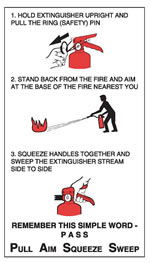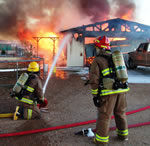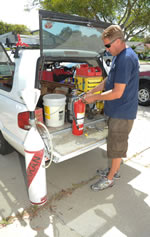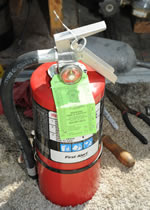Hot Issue: Automotive Fire Extinguishers - Page 3 of 4
 |
 |
by Hib Halverson
© November 2012
No use without permission, All Rights Reserved
How to Use a Fire Extinguisher
If you retain only one idea from this article, remember: “PASS," an acronym which might save your Vette, your house-or your life. That’s P for: pull the ring pin, A for: aim at the base of the flames, S for: squeeze the handles together and S for: sweep the nozzle from one side of the fire to the other.
Confronted with a fire, first, make the fight-or-flight decision. In your determination to either try and put out the fire or stand back and wait for a fire truck, consider the type and size of the fire, the rating of your extinguisher, your experience and your intestinal fortitude.
Let’s say a fuel hose broke, gas pooled on top of your engine then dripped onto the headers and...poof! The engine bay is going up and the flames are four feet high. You have a little 2-B:C-rated fire extinguisher you bought at a convenience store. Run the other way and call 911. Tell the dispatcher your location and that there’s a vehicle fire with the engine fully involved, then wait for the firemen.
On the other hand, if you are confident of your abilities, the wind is not blowing too hard and you’re armed with a 1-A:10-B:C fire bottle, you stand a good chance of getting the fire out.
Make sure you have a clear escape route in case the fire gets too large-best is to have that escape route at your back. If you have to run a distance to the fire and your extinguisher is a larger unit, carry it cradled in your arms like a baby. Deploy your fire extinguisher by holding the handles in your right hand and have the fingers on your left hand on the ring pin. Then, approach the fire from upwind, to distance of six-to-ten feet, and-PASS. Pull the pin then, aim at the base of the flames, squeeze the handles and sweep the discharge nozzle from side-to-side.
If the fire is under the hood and the hood is closed, don’t open it! The blast of fresh air often will cause the fire to flare up in your face. Approach the front of the car, get down low and attempt to spray the powder under the front end and up into the engine bay. Another firefighter's trick for a "closed-hood fire" is to point the nozzle at the ground under the engine and behind a front tire then try and "bounce" the spray off the ground and into the space under the hood. As soon as the fire is out, wash down the burned area with water to cool any remaining fuel and wash away the dry chemical agent.
How about a fire in your garage or shop? Say you’re using a cutting wheel to shorten some tubing you have chucked in a vise and you don’t see sparks flying into the trash can behind you. The day before, you filled the can with some oily rags and paper scraps. Suddenly, you smell smoke and turn around to find the trash can a raging inferno and your favorite Kyle Bush wall poster starting to burn.
First, make sure you have an escape route in case the fire gets too big, then grab that 3-A:40-B:C extinguisher you’ve kept hanging next to your bench. Pull the pin, aim at the trash can then squeeze the handles and, in this case sweep side-to-side along with up and down, so you get the burning wall poster as well as the trash can.
Want more information? You can find videos of how to use fire extinguishers on U-Tube. Also, some local fire departments offer fire extinguisher training. Lastly, employers, as a function of their companies’ safety programs, may offer fire extinguisher training.
Maintenance
For this article, we had Nargan Fire and Safety, a fire extinguisher service in the south end of California's Central Coast, service two extinguishers for us. In business since 1964, Nargan has mobile units and the representative who responded to our west coast office was Eric Persson, one of Nargan's licensed fire suppression equipment service technicians.
Persson has a decade of experience working with fire extinguishers. Figuring he knew a great deal about various brands, we queried him. He told us that Nargan is an Amerex Corporation dealer and that they prefer Amerex extinguishers because of their quality, durability and ease of service. Persson also suggested Tyco's "Ansul" brand as another good choice. He added that some extinguishers, popular with consumers because of low prices, are not as durable and more difficult to service than Ansul and Amerex units. Persson added that some extinguishers are made offshore and some of those have proven deficient in quality.
Some of the Kidde extinguishers we evaluated for this story had "Made in Mexico" printed on their cylinders. Upon removing one of the Mexican sourced units from factory packaging, we found it discharged. We had Nargan recharge it and during its disassembly, Eric Persson showed us where the ABC dry chem had caked around the top of the cylinder and told us that meant moisture was in the extinguishing agent. Moistened fire suppression agent is a quality problem which can cause extinguisher failure. Persson identified a second problem with the same unit: the valve seat inside the handle assembly was square rather than machined at an angle to match the conical rubber seal on the valve. It was unknown whether that was a manufacturing defect or a deficient design, but either way, the sharp edge will likely compromise the life of the seal. Eric Persson said that that moisture compromising extinguisher reliability and parts quality issues are problems with foreign-made extinguishers to the point that Nargan Fire and Safety prefers not sell those brands.
The other extinguisher we had Nargan Fire and Safety recharge was an older Pittway "First Alert" 2-A:10-B:C unit. It had no moisture in it and a beveled valve seat in the handle assembly. After recharging, that unit was returned to service in our shop.
At the end our extinguisher recharge session, Persson reviewed a few maintenance basics with us. He said a fire extinguisher’s pressure gauge should be checked every month. If the needle is in the red zone, it must be recharged by a licensed fire extinguisher service vendor. If you discharge an extinguisher, have it recharged as soon as possible. Eric explained that fire extinguishers which are not used should be inspected annually by a licensed fire extinguisher service vendor. Extinguisher cylinders must be hydrostatically tested every 12 years. No licensed fire extinguisher service vendor will refill an extinguisher with an out-of-date cylinder. To "hydrostat" a fire extinguisher cylinder is expensive so, with some low cost units sold to consumers, it’s less costly to simply replace them.
 |
 |





